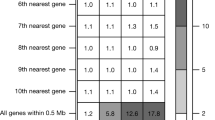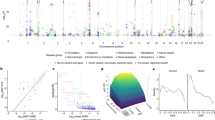Abstract
We report a genome-wide association (GWA) study of severe malaria in The Gambia. The initial GWA scan included 2,500 children genotyped on the Affymetrix 500K GeneChip, and a replication study included 3,400 children. We used this to examine the performance of GWA methods in Africa. We found considerable population stratification, and also that signals of association at known malaria resistance loci were greatly attenuated owing to weak linkage disequilibrium (LD). To investigate possible solutions to the problem of low LD, we focused on the HbS locus, sequencing this region of the genome in 62 Gambian individuals and then using these data to conduct multipoint imputation in the GWA samples. This increased the signal of association, from P = 4 × 10−7 to P = 4 × 10−14, with the peak of the signal located precisely at the HbS causal variant. Our findings provide proof of principle that fine-resolution multipoint imputation, based on population-specific sequencing data, can substantially boost authentic GWA signals and enable fine mapping of causal variants in African populations.
This is a preview of subscription content, access via your institution
Access options
Subscribe to this journal
Receive 12 print issues and online access
$259.00 per year
only $21.58 per issue
Buy this article
- Purchase on SpringerLink
- Instant access to full article PDF
Prices may be subject to local taxes which are calculated during checkout






Similar content being viewed by others
References
Snow, R.W., Guerra, C.A., Noor, A.M., Myint, H.Y. & Hay, S.I. The global distribution of clinical episodes of Plasmodium falciparum malaria. Nature 434, 214–217 (2005).
Greenwood, B.M. et al. Mortality and morbidity from malaria among children in a rural area of The Gambia, West Africa. Trans. R. Soc. Trop. Med. Hyg. 81, 478–486 (1987).
Mackinnon, M.J., Mwangi, T.W., Snow, R.W., Marsh, K. & Williams, T.N. Heritability of Malaria in Africa. PLoS Med. 2, e340 (2005).
Malaria Genomic Epidemiology Network. A global network for investigating the genomic epidemiology of malaria. Nature 456, 732–737 (2008).
International HapMap Consortium. A haplotype map of the human genome. Nature 437, 1299–1320 (2005).
Price, A.L. et al. Principal components analysis corrects for stratification in genome-wide association studies. Nat. Genet. 38, 904–909 (2006).
Pritchard, J.K., Stephens, M. & Donnelly, P. Inference of population structure using multilocus genotype data. Genetics 155, 945–959 (2000).
Frazer, K.A. et al. A second generation human haplotype map of over 3.1 million SNPs. Nature 449, 851–861 (2007).
Wellcome Trust Case Control Consortium. Genome-wide association study of 14,000 cases of seven common diseases and 3,000 shared controls. Nature 447, 661–678 (2007).
Marchini, J., Howie, B., Myers, S., McVean, G. & Donnelly, P. A new multipoint method for genome-wide association studies by imputation of genotypes. Nat. Genet. 39, 906–913 (2007).
Hanchard, N. et al. Classical sickle beta-globin haplotypes exhibit a high degree of long-range haplotype similarity in African and Afro-Caribbean populations. BMC Genet. 8, 52 (2007).
Chakravarti, A. et al. Nonuniform recombination within the human beta-globin gene cluster. Am. J. Hum. Genet. 36, 1239–1258 (1984).
Pagnier, J. et al. Evidence for the multicentric origin of the sickle cell hemoglobin gene in Africa. Proc. Natl. Acad. Sci. USA 81, 1771–1773 (1984).
Chebloune, Y. et al. Structural analysis of the 5′ flanking region of the beta-globin gene in African sickle cell anemia patients: further evidence for three origins of the sickle cell mutation in Africa. Proc. Natl. Acad. Sci. USA 85, 4431–4435 (1988).
Ruwende, C. et al. Natural selection of hemi- and heterozygotes for G6PD deficiency in Africa by resistance to severe malaria. Nature 376, 246–249 (1995).
Tishkoff, S.A. et al. Haplotype diversity and linkage disequilibrium at human G6PD: recent origin of alleles that confer malarial resistance. Science 293, 455–462 (2001).
Guindo, A., Fairhurst, R.M., Doumbo, O.K., Wellems, T.E. & Diallo, D.A. X-linked G6PD deficiency protects hemizygous males but not heterozygous females against severe malaria. PLoS Med. 4, e66 (2007).
Flint, J. et al. High frequencies of alpha-thalassaemia are the result of natural selection by malaria. Nature 321, 744–750 (1986).
Mockenhaupt, F.P. et al. Alpha(+)-thalassemia protects African children from severe malaria. Blood 104, 2003–2006 (2004).
Williams, T.N. et al. Both heterozygous and homozygous {alpha}+thalassemia protect against severe and fatal Plasmodium falciparum malaria on the coast of Kenya. Blood 106, 368–371 (2005).
Cappellini, M.D. & Fiorelli, G. Glucose-6-phosphate dehydrogenase deficiency. Lancet 371, 64–74 (2008).
Fry, A.E. et al. Common variation in the ABO glycosyltransferase is associated with susceptibility to severe Plasmodium falciparum malaria. Hum. Mol. Genet. 17, 567–576 (2008).
Marsh, K. et al. Indicators of life-threatening malaria in African children. N. Engl. J. Med. 332, 1399–1404 (1995).
Taylor, T. et al. Standardized data collection for multi-center clinical studies of severe malaria in African children: establishing the SMAC network. Trans. R. Soc. Trop. Med. Hyg. 100, 615–622 (2006).
Romans, P., Black, W.C., Sakai, R.K. & Gwadz, R.W. Linkage of a gene causing malaria refractoriness to Diphenol oxidase-A2 on chromosome 3 of Anopheles gambiae. Am. J. Trop. Med. Hyg. 60, 22–29 (1999).
Tishkoff, S.A. & Williams, S.M. Genetic analysis of African populations: human evolution and complex disease. Nat. Rev. Genet. 3, 611–621 (2002).
Dudbridge, F. & Gusnanto, A. Estimation of significance thresholds for genomewide association scans. Genet. Epidemiol. 32, 227–234 (2008).
Pe'er, I., Yelensky, R., Altshuler, D. & Daly, M.J. Estimation of the multiple testing burden for genomewide association studies of nearly all common variants. Genet. Epidemiol. 32, 381–385 (2008).
Agarwal, A. et al. Hemoglobin C associated with protection from severe malaria in the Dogon of Mali, a West African population with a low prevalence of hemoglobin S. Blood 96, 2358–2363 (2000).
Modiano, D. et al. Haemoglobin S and haemoglobin C: 'quick but costly' versus 'slow but gratis' genetic adaptations to Plasmodium falciparum malaria. Hum. Mol. Genet. 17, 789–799 (2008).
Barrett, J.C. & Cardon, L.R. Evaluating coverage of genome-wide association studies. Nat. Genet. 38, 659–662 (2006).
Conrad, D.F. et al. A worldwide survey of haplotype variation and linkage disequilibrium in the human genome. Nat. Genet. 38, 1251–1260 (2006).
de Bakker, P.I. et al. Efficiency and power in genetic association studies. Nat. Genet. 37, 1217–1223 (2005).
Pe'er, I. et al. Evaluating and improving power in whole-genome association studies using fixed marker sets. Nat. Genet. 38, 663–667 (2006).
Bhangale, T.R., Rieder, M.J. & Nickerson, D.A. Estimating coverage and power for genetic association studies using near-complete variation data. Nat. Genet. 40, 841–843 (2008).
World Health Organization. Communicable Diseases Cluster. Severe falciparum malaria. Trans. R. Soc. Trop. Med. Hyg 94 (Suppl. 1), S1–S90 (2000).
Molyneux, M.E., Taylor, T.E., Wirima, J.J. & Borgstein, A. Clinical features and prognostic indicators in paediatric cerebral malaria: a study of 131 comatose Malawian children. Q. J. Med. 71, 441–459 (1989).
Scheet, P. & Stephens, M. A fast and flexible statistical model for large-scale population genotype data: applications to inferring missing genotypes and haplotypic phase. Am. J. Hum. Genet. 78, 629–644 (2006).
Acknowledgements
We thank the Gambian children and their parents and guardians who made this study possible; and the doctors, nurses and fieldworkers at the Royal Victoria Hospital, Banjul and other health clinics who assisted with this work. MalariaGEN's primary funding is from the Wellcome Trust (grant number 077383/Z/05/Z) and from the Bill & Melinda Gates Foundation, through the Foundation for the National Institutes of Health (grant number 566) as part of the Grand Challenges in Global Health initiative. The Wellcome Trust (Sanger Institute core funding) and the Medical Research Council (grant number G0600230) provide additional support for genotyping, bioinformatics and analysis. The MalariaGEN Resource Centre is part of the European Union Network of Excellence on the Biology and Pathology of Malaria Parasites.
Author information
Authors and Affiliations
Consortia
Contributions
The clinical study in The Gambia was designed and carried out by M.J., K.A.B., D.J.C., D.P.K., M. Pinder, G.S., F.S.-J. and S.U. Genotyping and sequencing studies were designed and performed by K.A.R., P. Deloukas, S.A., S.J.B., S.C., A.C., A. Dunham, A.E.F., A.G., R.G., S.E.H., M. Inouye, A.E.J., K.K., A. Mendy, A.P., S.P., J. Ragoussis, J. Rogers, K.R., E.S., P.W. and C.W. The analysis group comprised Y.Y.T., K.S.S., T.G.C., P. Donnelly, J. Marchini, A. Morris, M.S. and D.P.K. This study forms part of a multicenter investigation of genetic resistance to malaria led by E.A.A., T.A., S.A., O.A., K.A.B., D.J.C., P.C., P. Deloukas, A. Djimde, A. Dolo, O.K.D., C.D., S.D., J.E., J.F., D.F., T.T.H., R.D.H., M. Ibrahim, N.K., G.K., K.A.K., D.P.K., M.L., J. Makani, K.M., P.M., D.M., M.E.M., I.M., M. Parker, N.P., C.V.P., O.P., J. Ragoussis, J. Rogers, J. Reeder, H.R., E.M.R., A.S., P.S., S.S., G.S., A.T., T.E.T., M.T., M.T.-B., T.N.W. and M.W. The manuscript was written by D.P.K., Y.Y.T. and K.S.S.
Corresponding author
Additional information
A full list of members is provided in the Supplementary Note.
A full list of members is provided in the Supplementary Note.
Supplementary information
Supplementary Text and Figures
Supplementary Figures 1–10, Supplementary Tables 1–4, Supplementary Methods and Supplementary Note (PDF 1193 kb)
Rights and permissions
About this article
Cite this article
Jallow, M., Teo, Y., Small, K. et al. Genome-wide and fine-resolution association analysis of malaria in West Africa. Nat Genet 41, 657–665 (2009). https://doi.org/10.1038/ng.388
Received:
Accepted:
Published:
Issue date:
DOI: https://doi.org/10.1038/ng.388
This article is cited by
-
ATP2B4 regulatory genetic variants are associated with mild malaria
Malaria Journal (2023)
-
Risk score prediction model based on single nucleotide polymorphism for predicting malaria: a machine learning approach
BMC Bioinformatics (2022)
-
Leveraging Mann–Whitney U test on large-scale genetic variation data for analysing malaria genetic markers
Malaria Journal (2022)
-
Racial and ethnic disparities in genetic testing for hearing loss: a systematic review and synthesis
Human Genetics (2022)
-
Genetic factors affect the susceptibility to bacterial infections in diabetes
Scientific Reports (2021)



